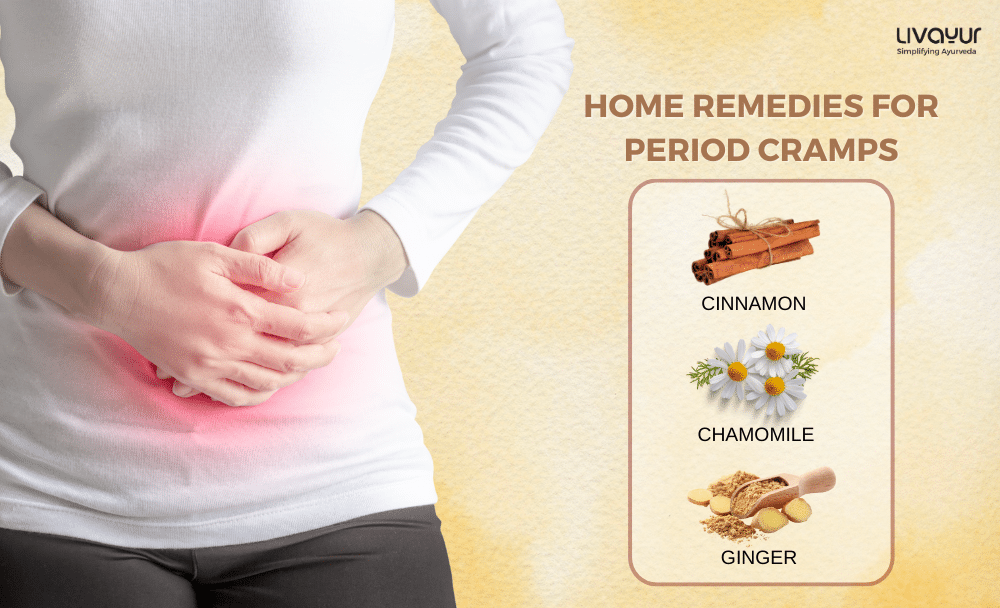
Period cramps also known as menstrual cramps is a cramping or throbbing pain that women feel on their lower abdomen during their normal menstrual cycle every month. To get an answer to the question what are period cramps, you need to understand the physiological reason behind such pain. The scientific term dysmenorrhea [1]
stands for period cramps meaning. Though Dysmenorrhea, a common phenomenon, is secondary to several gynecological issues, it also manifests in most suffering women as a primary disease form.[3]
When a pregnancy doesn’t happen, the uterus sheds off its inner lining in the form of vaginal bleeding and during the elimination of the uterine lining the uterus of a woman contracts resulting in pain that may range in intensity from mild to severe. Apart from pain in the lower abdomen, period cramps can bring with it other symptoms like pain in the upper thighs, lower back, groin and head. It may also come with symptoms like diarrhea, vomiting and nausea.[1]. Adolescent girls who just got their periods might also experience lethargy, tiredness, depression and lack of concentration.[2]. Thus, period cramps result in a kind of negative emotional and sensory experience.[3]
What are period cramps types
Before we go into the details of period cramps solution, it is worthwhile to learn about the various period cramp types. There are two major types of period cramps:
Primary dysmenorrhea
Primary dysmenorrhea is the commonest form of period cramp. This type of period cramp is not the result of any underlying condition. High amounts of prostaglandins, a lipid acting similar to hormones, can trigger primary dysmenorrhea.[1] Prostaglandins are made by the uterus of a woman. This type of pain starts one or two days before the menses and tends to reduce after the monthly cycle is over. Generally young girls who have just attained menarche will have this pain. As the girl matures to becomes a woman, the pain reduces. Childbearing happens to be a highly impactful factor for bringing down the intensity of dysmenorrhea.[3]
Primary dysmenorrhea is not fatal for life but definitely deteriorates the quality of your life. [4] According to stats 70% of adolescent girls and 50% of mature, menstruating women complain of primary dysmenorrhea.[11]
Secondary dysmenorrhea
Secondary dysmenorrhea starts in the later part of a woman’s life. Certain ailments of the female reproductive system like uterine fibroids and endometriosis can lead to this type of period cramp.[1] The pain associated with Secondary dysmenorrhea worsens with the passage of time.
What causes period cramps?
If you wish to know what causes period cramps, here are the possible causes:
Increased prostaglandin production
Increased production of prostaglandins, specifically of types, PGF 2a as well as PGF 2, results in amplified uterine contractions and tone. Women suffering from dysmenorrhea have higher prostaglandins levels, which peak during the first two days of menstruation. The making of Prostaglandin is affected by progesterone: when the level of progesterone falls, prior to menses, prostaglandin levels rise.[3]
Underlying Conditions
Period cramps may result from underlying conditions such as pelvic inflammatory disease, endometriosis, adenomyosis, ovarian cysts, and uterine myomas. [4].
- When the endometrial tissue starts growing outside a woman’s uterus mostly on ovaries or fallopian tubes, the condition is referred to as endometriosis.
- When the tissue on the uterine lining starts growing into the uterus walls, the condition is referred to as adenomyosis.
- When a woman’s reproductive organs get infected mainly due to sexually transmitted microorganisms, the result is pelvic inflammatory disease.
- When benign fluid-filled sacs develop on the ovaries, the condition is referred to as cystic ovaries.
- When benign growths develop on the uterine wall, they are called uterine myomas.
Home remedies for period cramps
How to reduce period cramps? There are several ways to reduce period cramps. If you wish to know how to relieve period cramps fast, you can follow the given tips:
- Using a heat pad on the lower abdomen
- Taking shower with hot water
- Taking over-the-counter painkillers like Non-steroidal anti-inflammatory drugs (NSAIDs).The common ones are naproxen and ibuprofen. [1]
- Massing with certain specific aromatic essential oils such as peppermint oil, fennel oil, lavender oil and rose oil. [5]
Long-term measures for period cramp management
- Managing period pain includes lifestyle changes too. Practicing yoga and aerobic exercises. [6] can help to a large extent. So, now you know how to deal with period cramps in the long run.
- Watch out for your diet. Healthy food rich in vitamins and minerals can have a positive impact on your overall health and can make your periods less painful.
- Take magnesium supplements for better period cramps management.[7]
Also read about 9 best magnesium rich foods
- The non-invasive approach of Acupressure has been seen as an effective measure for pain management. The technique involves applying pressure on certain parts of one’s body. Those parts are referred to as acupoints. According to studies [8] acupressure can lower the intensity of period cramps.
- Use of contraceptive pills also known as birth control pills can help alleviate period pain by stopping ovulation and controlling Prostaglandins production. [9]. So, one of the answers for what to do for period cramps, is start taking these pills after consulting a gynecologist.
- Use of electrical currents to treat period cramps has shown promising results with regard to pain management. Thus, TENS machines can be helpful.[10]
Ayurvedic home remedies for period cramps

Ayurveda has a solution for everything. When it comes to period cramps, there are some potent Ayurvedic herbs to address your raging period cramps. To get an answer to the question how to get relief from period cramps with Ayurveda, read on:
- Cinnamon (Tvak)
Cinnamon has medicinal properties to fight menstrual cramps by reducing the amount of prostaglandins.[12]Cinnamon also has anti-inflammatory and antispasmodic properties. 1 teaspoon of cinnamon powder mixed in a glassful of lukewarm water can be used as a period cramp management remedy.
- Black Cohosh (Cimicifuga racemosa)
Anti-inflammatory nature of this wonderful herb can reduce the intensity of period cramps. A decoction made out of the root of Black Cohosh can be effective.[12]
- Chamomile (Matricaria chamomilla)
The dried flowers of this herb can be used to make a tea that comes with a sweet, floral aroma and taste. Chamomile tea can help fight the depression and discomfort associated with menstrual cramps by promoting good sleep and relaxation [12]
- Ginger (Adrak, Shunti)
Ginger has pain-relieving capacity. Intake of 200 mg of the herb at an interval of 6 hours showed promising results with regard to period cramps management.[12] Taking ginger tea is helpful for the management of period cramps.
- Peppermint (Pudina)
A strong compound called Menthol present in peppermint can have an analgesic impact with regard to period pain management. Taking peppermint tea made from the leaves of peppermint during menstruation can help.[13]
Conclusion
So, now you know how to reduce period cramps. Apply the above-mentioned home remedies for period cramps to get relief from the predicament every month. If nothing works and if the pain worsens every time you have a period, then you must visit a doctor and get the necessary medical assessments done.
FAQs
- Q. When do period cramps start?
Period cramps start soon after the starting of the menses, roughly around the age of 13 or 14.
- Q. Can IUD (Intrauterine Device) be used for period pain management?
Yes, IUDs can be used for period pain management. But, you must consult an obstetrician before opting for this method.
- Q. Does family history increase the risk of period cramps?
Yes, it does. But you can avoid it by following a healthy lifestyle, such as eating healthy, exercising regularly, and following stress relief techniques.
Disclaimer
This article is written for informing the readers about the remedies for period pain and is not medical advice. Before using any remedy, you must consult a doctor.
References
- Period Pain
- A Study of Dysmenorrhea During Menstruation in Adolescent Girls
- Dysmenorrhea and related disorders
- Dysmenorrhea among high-school students and its associated factors in Kuwait
- Aromatherapy for Managing Pain in Primary Dysmenorrhea: A Systematic Review of Randomized Placebo-Controlled Trials
- The Effect of aerobic exercise on primary dysmenorrhea: A clinical trial study
- Magnesium in the gynecological practice: a literature review
- Effect of Acupressure on Primary Dysmenorrhea: Review of Experimental Studies
- Oral contraceptive pill for primary dysmenorrhoea
- Transcutaneous Electrical Nerve Stimulation (TENS) for Primary Dysmenorrhea: An Overview
- Herbal Medicine in the Treatment of Primary Dysmenorrhea
- Evaluation of mint efficacy regarding dysmenorrhea in comparison with mefenamic acid: A double blinded randomized crossover study
- Ayurvedic Management of Primary Dysmenorrhea with Abhayatrivrudadi Kashayam- Case Report




















